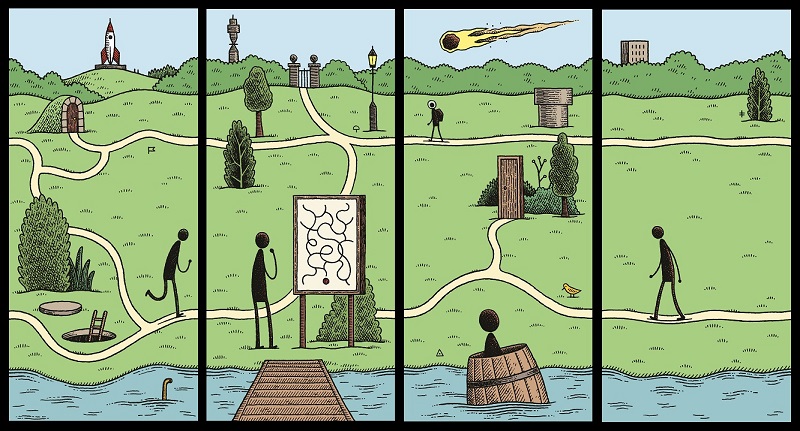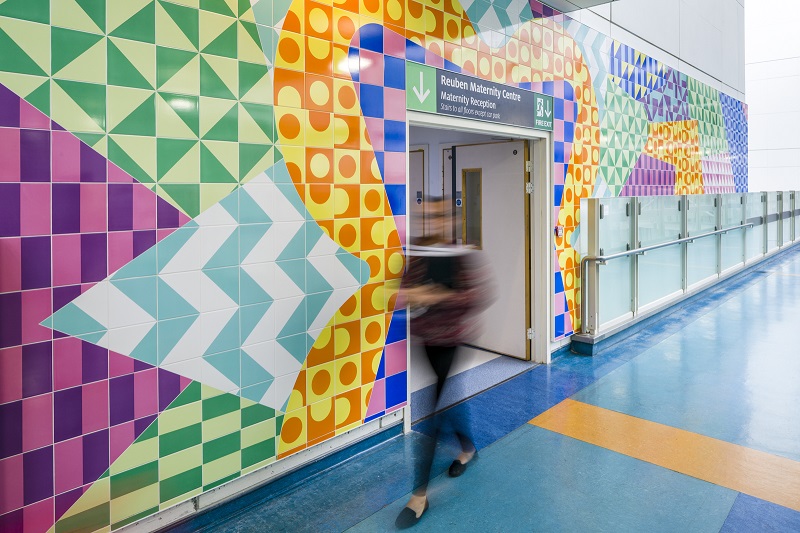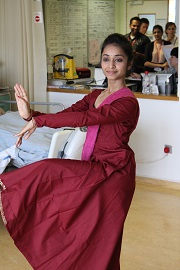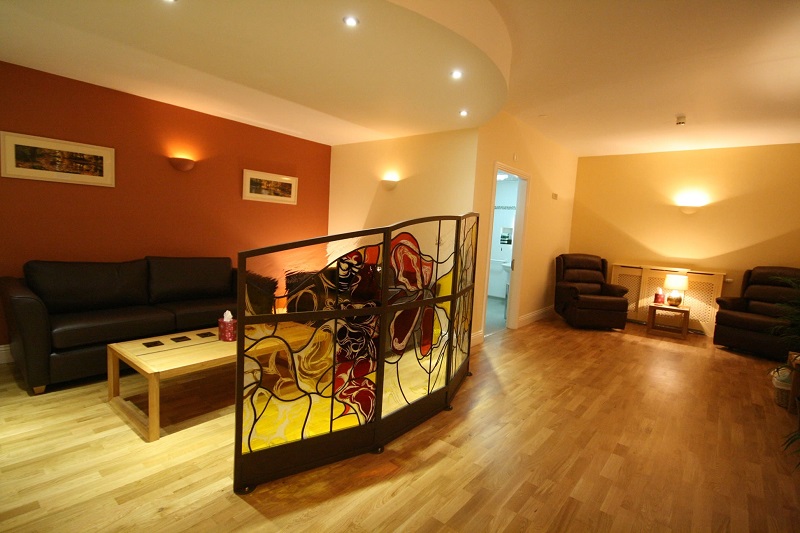Art matters.
It matters because people – patients, staff and visitors – are not machines and so staring at white walls and barren corridors can be somewhat demoralising.
Acknowledging this fact, Northumbria Healthcare NHS Foundation Trust has, for the past 20 years, taken the view that a healing environment is an important aspect of any hospital.
“It is a hard but inescapable truth that in most healthcare environments people are reminded of physical frailty, of vulnerability and, sadly, of pain,” said Brenda Longstaff, head of the trust’s Bright Northumbria hospital charity.
“Art can counteract these thoughts.
“Done right, art will foster a positive environment; feeding the soul and inspiring hope in the mind.”
Done right, art will foster a positive environment; feeding the soul and inspiring hope in the mind
But is hospital art being ‘done right’ every time?
Not according to some.
Catsou Roberts, director of Vital Arts, the charitably-funded arts and health service within Barts Health NHS Trust, says there is still much to be done.
A bit of ambition
She adds: “Art in healthcare needs to be ambitious.
“If hospitals are just pasting vacuous decorations onto walls, then they are missing an opportunity to change society for the better. Art in hospitals could be opening minds and extending horizons.”
In the last 12 months alone a number of very-important reports have been published that will help teams to very persuasively make the case for the positive impact these schemes can have on health.
These include Creative Health - drafted by the APPG for Arts, Health and Wellbeing; Changing Lives: the social impact of participation in culture and sport - by DCMS; and Public Investment, Public Gain - by the Creative Industries Federation.
It is a hard but inescapable truth that in most healthcare environments people are reminded of physical frailty, of vulnerability and, sadly, of pain. Art can counteract these thoughts
In addition to this, Arts Council England has named health and wellbeing as a priority in its draft strategy for the coming 10 years (2020-2030) and has been heavily involved in the move towards social prescribing.
But, says Roberts, it is still often an afterthought.
One of the stumbling blocks currently, she reveals, is how artists are chosen and commissioned.
“We generally work with modest budgets and manage to deliver enriching projects. Let’s be clear, though: art projects are not frontline medicine; they are not saving lives.
“We fundraise for individual projects from external sources, so we are accustomed to working resourcefully.”
She adds: “It’s important to have experience working with artists.
“Often artists with international reputations are keen to work with us. Everyone in the UK has some connection to the NHS, and many artists agree to work within our modest budgets in order to give back to the NHS.”
And, she advises: “Art has to be site specific, patient responsive, and sensitive to the particular hospital context.
“Work within a bereavement suite, for example, will be totally different to art installed in a paediatric waiting area.

Vital Arts, the charitably-funded arts and health service within Barts Health NHS Trust, is at the forefront of delivering arts in health projects
Board buy-in
“We think long and hard about who we are commissioning for and why we are doing it. It's a labour of love.
“And support at board level is key. Ideally senior management and clinical staff would believe in the benefits that ambitious art can have to enhance recovery, and improve the patient experience and clinical environment.”
If hospitals are just pasting vacuous decorations onto walls, then they are missing an opportunity to change society for the better. Art in hospitals could be opening minds and extending horizons
Recent projects by Vital Arts have included a ward-wide installation by cartoonist, Tom Gauld, which was developed after conversations with the cystic fibrosis patients using the unit.
The organisation also has a museum-quality collection of more than 2,000 objects; runs an artist-in-residency programme; and stages temporary exhibitions to serve the five east London hospitals within the trust.
And it devises patient participation projects run by artists, such as a recent workshops for young patients exploring emotional storytelling through drawing, painting and collage making; and a series of inter-generational creative workshops for older patients and schoolchildren.
Northumbria Healthcare NHS Foundation Trust also advocates working closely with highly-regarded artists on site-specific projects.
“Every NHS organisation faces a squeeze on its finances and all too often ‘art’ is an easy item to strike from the budget,” said Longstaff.

Ceramic installation commissioned by CW+ at Chelsea and Westminster Hospital, by Adam Nathaniel Furman. Image courtesy of Gareth Gardner
“However, with careful planning – often months or years in advance – it is possible to incorporate art into wider programmes of works.
“The other critical factor is to reassure clinical teams and the wider public that such funding isn’t ‘taking away’ from core services.
“Transparency is the key – as is badging art under a charitable identity; demonstrating a value added rather than a cost incurred.”
Though the trust covers 11 acute sites, and one of the largest geographies of any English NHS organisation, they chose to start small, learning what works and how to engage stakeholders.
“Now have a tried-and-tested way of working which has been replicated across the trust.
Everyone in the UK has some connection to the NHS, and many artists agree to work within our modest budgets in order to give back to the NHS
“In each case, we start by identifying fixed locations for art displays and then install high-quality, secure frames in a range of sizes. This allows for flexibility and for displays to be refreshed easily and without damaging the building.
A false economy
“We also learnt quickly not to use cheap materials; they don’t last and it’s a false economy.

CW+ devises patient participation projects run by artists, including dance sessions with Akademi
“Flash forward two decades and thousands of different pictures, paintings and other forms of art have now been displayed on the various sites.”
Starting small has also allowed them to grow big.
One of the trust’s finest projects to date – and one that has had the largest direct impact on patients and their families – is the ‘Oasis’ at Wansbeck General Hospital.
Developed in partnership with Teesside University’s School of Interior Design it offers a place of calm and tranquillity; often at moments of extraordinary stress or horrific heartache for families.
“Hundreds have now benefitted and the feedback is deeply moving – going the extra mile means so very much,” said Longstaff.
She added: “With the wellbeing agenda rising in prominence, and with the emergence of social prescribing into the mainstream; I am confident that – with planning and a little luck – art will form part of the NHS’s toolkit in years to come.
“Closer to home, Northumbria continues to develop the arts and makes sure to involve the clinical teams at an early stage when developing new hospital sites.
“The arts have definitely provided us with a powerful medium to build close connections with our local communities.”
Every NHS organisation faces a squeeze on its finances and all too often ‘art’ is an easy item to strike from the budget
A third hospital spearheading the inclusion of arts in interior design is Chelsea and Westminster Hospital NHS Foundation Trust, whose CW+ arts group recently unveiled its book, The Healing Arts, which celebrates 25 years of the trust’s arts programme.
“The CW+ arts programme actively supports the physical, mental and emotional experience and recovery of patients – in some cases, shortening their stay or reducing their need for pain medication,” said Chris Chaney, chief executive of CW+.

Northumbria Healthcare NHS Foundation Trust has undertaken hundreds of projects, including the revamp of a relatives room at Wansbeck General Hospital
Reaping the benefits
Director of the patient environment, Trystan Hawkins, adds: “Involving a range of different stakeholders, including patients, is essential. It is also important to be able to adjust and refine projects to changing requirements.”
With the wellbeing agenda rising in prominence, and with the emergence of social prescribing into the mainstream; I am confident that – with planning and a little luck – art will form part of the NHS’s toolkit in years to come
And, he agrees with Roberts that getting buy-in at board level is crucial.
“It is important to build meaningful relationships with the teams on the ground, who see patients every day and are aware of their needs. In turn, this helps to construct a dialogue and build standing with management who will then see the benefits,” he adds.
